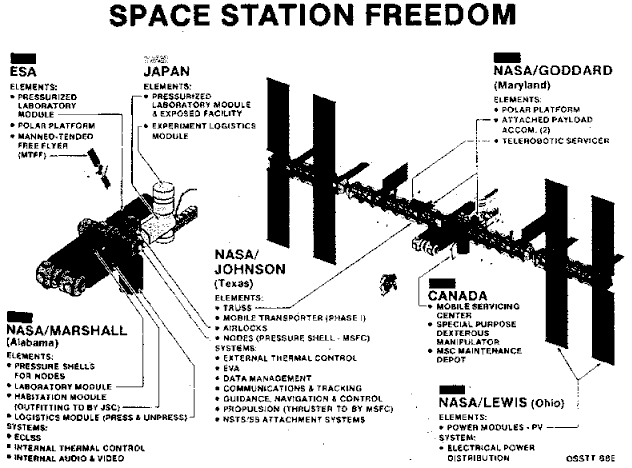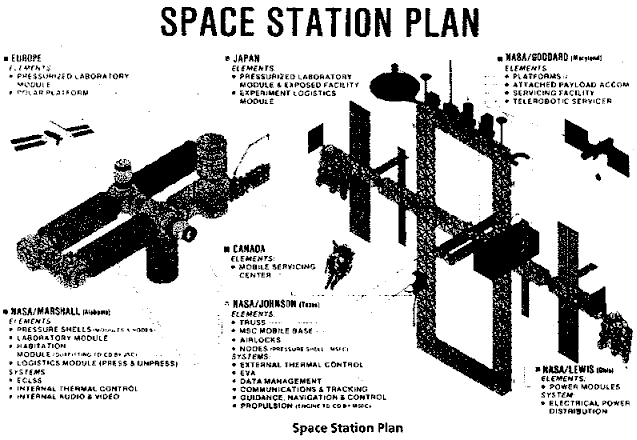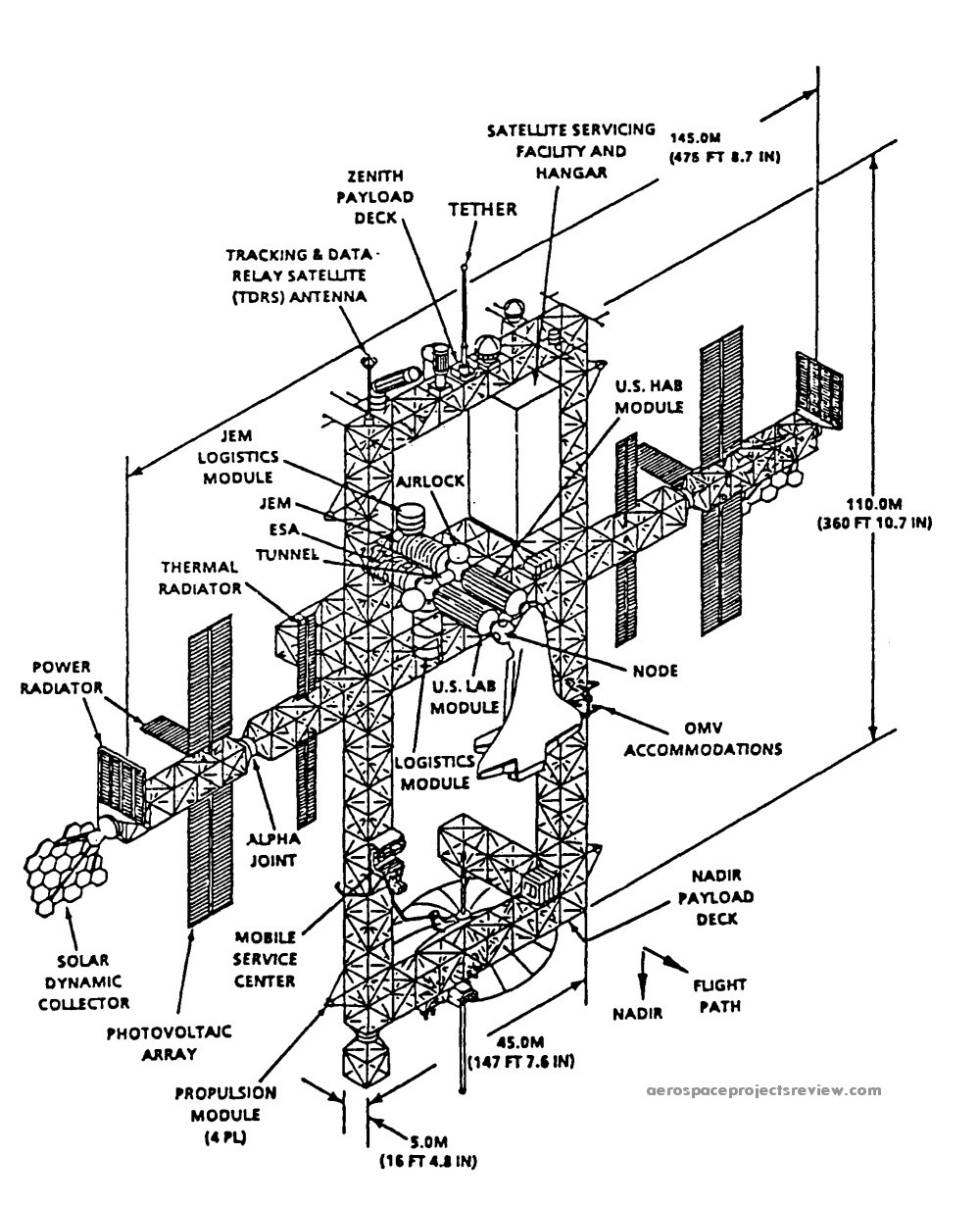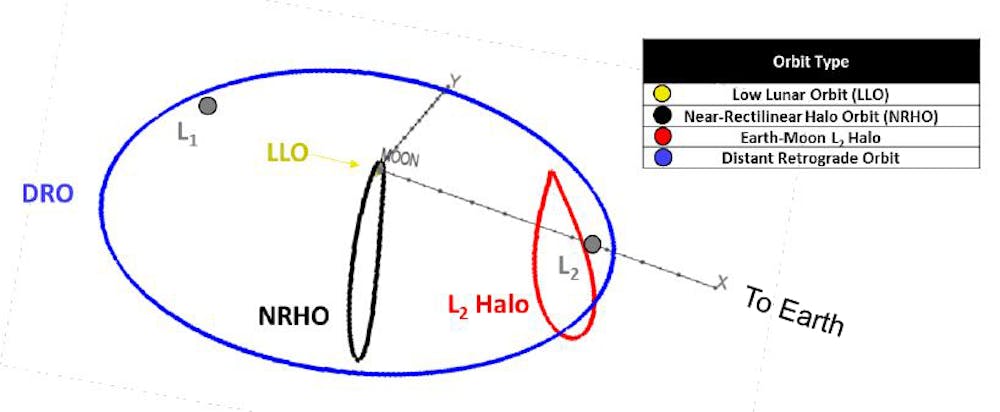I thought the plan all along was to close this project down by 2024 anyway? And build something new? Honestly I'd rather dump the money into getting back to the Moon or to Mars or both. Or colonies on both or either. I'd be nice to be able to retired to the retirement colony on Mars one day... I'm more for making permanent things that just these one off couple decades ideas......
-
2018-01-26, 08:11 PM #121
-
2018-01-26, 11:05 PM #122
Another 1987 Space Station Freedom diagram from NASA.

You can see with the named facilities on the final design, the ISS is a reorganized Space Station Freedom with the Russian segment added on.
The only parts missing really are the Control Module, Habitation Module and the Mann Tended Free flier. Most everything else (annd a few other parts) are all there, just in a different layout. The Contorl Module - basically the ISS's service module - had its job transfered to the Russian segment, which keeps the ISS on orbit and with life support.
Here's the 1985 Dual Keel SSF layout.



The thing about the dual keel design that you can probably gather from that second image, is that it's a lot of extra Truss (which means a lot more flights/construction) for things that were largely miniturized or relocated to the ISS's final truss structure.
The ISS is much larger than Mir, or the forthcoming Chinese Station.

-
2018-01-26, 11:09 PM #123
Has nothing to do with trump, the iss has been running on fumes for years and planned to be shut down when the shuttle program ended im pretty sure. I do enjoy everyone pinning this on trump though. When in reality we need to close down the ISS and build more permanant facility in orbit. preferably somthing with an orbital dock.
-
2018-01-26, 11:34 PM #124
The ISS was originally supposed to be deorbited in 2018, but was extended a few years back to 2024. The original 2018 date was set in the 1990s, and did not include the few years where construction was halted after the Columbia accident and the protracted return to flight. It was extended to 2024 recognizing that, with the ISS pretty much just finished then, they would not have any kind of Return on Investiment to deorbit it so fast.
The 2024 date was done with the understanding that the ISS could easily, maybe even should easily be extended to 2028. It is in very good shape overall (more on that in a moment), so there is no reason we couldn't get 10 years out of it. Between the lines, though, NASA was interested in 2032, or beyond.
The biggest problem with the ISS is financial.

Running the ISS proper costs $1.5 billion a year, but cargo and crew flights to it cost $2.2 billion a year.
This is the NASA budget
file:///M:/Downloads/fy_2017_budget_estimates.pdf
Go to page 460. to start. That's the ISS "keeping the lights on" budget. About $1.5 billion. Cheap.
The science budget, $321 million, can be found on page 467.
Where things get bad is in the $2.7 billion spent on Crew and Cargo / Commercial crew in 2017 on page 480. The Commercial crew part, at $1.184 billion is a development program for the SpaceX and Boeing manned vehicles. That is a temporary cost. The real offender is the $1.572 billion for operational crew and argo costs. These grows, rather than shrinks, as the commercial crew development budget shrinks and the money is shifted to operations instead in 2018, 2019 and 2020.
The biggest problem, if you go through the next 12 pages, is that it takes a lot of flights of small and comparatively expensive space vehicles to resupply the space station.
The SpaceX flights are cheap, but the US uses a lot of them because the Dragon Capsule isn't all that big (even though the launch capability of the Falcon 9 FT is now well over 10 tons more than is being utilized by an ISS launch), and because the Progress and SOyuz flights it buys from Russia are expensive and tiny. From October 2016 - September 2017, the US paid for 8 Progress/Soyuz flights from Russia, for a total of
A large part of this is due to Russians gouging. WHen the Shuttle was retired the raised the cost of seats on the Soyuz significantly (doubled it since 2011, nearly quadrupled since 2006). Also the cost of Progress flights went up.
This is a chart of how much NASA is spending on Soyuz seats. NASA is not buying any more Soyuz seats after 2018 because cheaper commercial crew will replace it.
[img]http://www.spaceflightinsider.com/wp-content/uploads/2016/10/OIG.jpg[/ig]

Great people we're working with on the ISS huh? Forreference a Falcon 9 flight with 4 US crew members to the ISS will cost about $70 million for an expendable, and ~$20 million for reusable.
Progress resuply vehicles are about $90 million for the launch vehicle and $30 million for the spacecraft, for a total of $120 million per resupply.
Basically, the ISS would be far more affordable if we cut the Russians out of it entirely and relied on commercial US launch providers to resupply it, preferably with larger cargo spacecraft (on existing launchers), launching fewer times per year.
-
2018-01-26, 11:37 PM #125
Yea thank god this guy wont be president in 2025. Quit funding the ISS.... what the fuck...
On the other hand, maybe it would open up some private funding. We just need to find a minable asteroid close enough and let some mega corproration fund all space exploration and science in return.

-
2018-01-26, 11:42 PM #126
-
2018-01-26, 11:42 PM #127
-
2018-01-26, 11:48 PM #128
An "orbital dock" doesn't get you anything IRL.
The place to construct spacecraft for Mars / Outer Solar system missions is in cislunar space, probably in a halo orbit at Earth-Moon L2.
http://theconversation.com/how-a-new...d-beyond-84823

This is exactly what NASA is now being funded to build, the Deep Space Gateway.
Unlike the ISS, the DSG will not be permanently manned, but rather be visited for 40-60 day stays as needed.
Also let's remember the scale of what a Mars mission would look like. A "dock" as you put it, would do what exactly? Mostly provide a habitation facility for the construction crew of the Mars craft. According the Mars Manned Mission Reference Design by NASA, the Mars craft, being built either in LEO or at Earth-Moon L2 would take about 4 years to be built and take 9-11 launches of a 105-130t class superheavy lift rocket (9 if nuclear powered, 11 if conventionally). And that's per 500 day mars Mission.
Space is hard.
This is the construction roadmap, starting with EM-2.

This is how it could be used to get to Mars.

This is how it could be expanded.
- - - Updated - - -
See my above post.
-
2018-01-26, 11:51 PM #129I am Murloc!


- Join Date
- Mar 2011
- Posts
- 5,993
That is what it costs to send someone up there with a roll of duck tape to fix the leaks.
I am not sure when is a good time to ditch the ISS, it is already in overtime. Here is a list of stuff they have done and I wonder what the waiting list looks like.
https://www.nasa.gov/mission_pages/s...s_by_name.html
IMO I see value it putting all that money toward other projects, like a moon base with a frikin huge laser beam(to shoot down asteroids of course).The whole problem with the world is that fools and fanatics are always so certain of themselves, but wiser people so full of doubts.
-
2018-01-26, 11:59 PM #130
See my post above. It's mostly about the cost of launching cargo and crew.
The cost of ground support and keeping the lights on on the ISS is pretty cheap. It's that flying people and cargo to space on small Russian vehicles, and SpaceX's Falcon 9's launch capacity being underutilized (thus having to launch more often per year) all adds more flights per year than would otherwise be needed.
There were fewer of these resupply flights in the Shuttle Era because the Shuttle carried an enormous amount of cargo (23 tons for the shuttle, compare to 2.4 tons for Progress, 6 tons for Dragon and 7.6 tons for the ESA's ATV).
The math is terrible. Progress launches 4 times per year, at a cumulative cost of $480 million for $9.6 tons of cargo. The Shuttle launches 4 times per year at $560 million per launch for $2.24 billion, but also 92 tons of cargo, AND you do crew swaps, which means you don't need to buy Soyuz flights for $130 million + $80 each either.
And the shuttle isn't even an efficient way to do it either. But it sure as hell beats the miniscule launch capability of Soyuz + Progress, which is too small for the ISS.
The best way is to have the Falcon 9's forthcoming Dragon V2 capsule have a larger cargo variant so they can get 10-12 tons to the ISS per flight and launch twice a year. The Falcon 9 has well beyond even that cargo capacity (factoring in the Dragon's mass, you could probably go up to around 16-17 tons).
- - - Updated - - -
China is not part of the ISS program, and under US law, NASA is banned from cooperation on anything in space with China (a very good law).
NASA wanted to bring China into the ISS program repeatedly in the 2000s and 2010. Congress wisely said "no, and don't ask again". We're not about to give the Chinese more of our strategic technology.
They play no role.
As for Russia, they don't pay for the ISS by in large. We do. And we're working on severing ourselves from them in space ever since their 2014 invasion of Ukraine. They're not going to be included in the Deep Space Gateway project.
-
2018-01-27, 12:10 AM #131
SPace is hard when all your using is basic bitch 2-3 stage rockets. We obviously need somthing bigger, or to build the shit up there. And by orbital dock i mean orbital shipyard,drydock, building facility. Bring a basic rock park it in a L point, take the metals and build from there. We arnt going to get anywhere remotly fast or well by building on the ground, shipping to orbit, and assembling interplanetary vehicles there.
-
2018-01-27, 12:15 AM #132
So it's at the end of it's life cycle and you all think we should keep budgeting money for something that wont even be there? Do you all keep sending the bank car payments after you've paid it off?
Me thinks Chromie has a whole lot of splaining to do!
-
2018-01-27, 12:17 AM #133
The chemical composition of most Earth-passing asteroids are not suitable for fabrication of materials for spacetravel. And how would we ever fabricate electronics? Even on earth, some critical metals only have one or two sources for them. We're talking about enormous facilities.
This is why orbital or off-planet fabrication has focused exclusively on fuels. This is why the Raptor engine for the BFR from SpaceX is methane fueled (you can make that readily on Mars). More complexity than fuels is something we're so very far away from.
-
2018-01-27, 12:22 AM #134
-
2018-01-27, 07:51 PM #135
Well it depends what NASA we're talking about, but 'NASA' is actually about ten field centers that are run like indepnedent kingdoms. NASA Headquarters as relatively weak control, and they do try and kill each other.
The NASA centers that focus on ISS work, like Johnson, form the core of the 'ISS lobby', which is the single most powerful constituency within NASA. If they could extend it to 2032 they would. The ISS Lobby has successful delayed or altered dozens of human space flight plans over the past 20 years because the impact it could potentially have on the ISS.
Why is this? THe ISS supports thousands of scientific jobs. Wherever NASA goes next, manned wise, will necessarily support fewer of the type currently employed (but more of other types). Its the usual thing you'd always expect with fiefdoms and money and all that.
There is also history behind it. NASA really never got over "giving up" Apollo architecture. It's made the institution terrified of loss and hyper conservative when it comes to change. For example, the upcoming Space Launch System is largely repackaged, upgraded, reconfigured Shuttle technology. NASA did not want to "lose' that even though, as SpaceX has illustrated, there is big benefits in clean sheet designs. And more specifically, NASA regrets leaving the moon and not fighting to go back, and is afraid if it "loses" the space station, it'll never get another.
And emotionally, you have to consider the people at NASA are passionate people about this entire field. They do it because they love it. A lot of them entered 30 or 40 years ago expecting to be headed to the Moon or Mars by the 2020s. Even Bush had planned a 2018 lunar landing in 2005 under the Constellation Archiecture.
In truth, if the first generation of NASA workers produced Mercury/Gemini/Apollo/Skylab/the Shuttle, the second generation has been all about Shuttle operations, Hubble, Mir-2, and ISS construction and use. That's their career. 40 years. But they were promised the Moon or Mars. They aren't getting it. The Moon or Mars will be the province of the next generation... people in their 20s and 30s now. Consider it from these older workers, in their 50s and 60s perspective. They worked at NASA for years, to send people to the Moon and Mars with the ISS as a gateway to long duration spaceflight, but more likely than not, they'll be 65-75 before humans walk on the moon again, and 85-95 before we go to Mars. Most of these people in other words, will have spent their lives working towards something that will arive after they retire or die.
It's too bad, but their legacy, as unsatisfied as they are with it, is a great one. So giving up the ISS isn't, to these people, just giving up an aging space vehicle. It's also the sunset of their career, even their lives in a sense. They may help on the starting stages of what comes next, but they won't be around to see it through.
-
2018-01-27, 08:40 PM #136Dreadlord


- Join Date
- Oct 2010
- Posts
- 842
Since 2025 puts this measure's effect just beyond a possible 8 year cycle for the current administration, I'm gonna call political shenanigans on it. They're just looking to push someone's buttons with this, or to use the threat of defunding as leverage for something.
-
2018-01-27, 08:54 PM #137
I don’t. People have a choice to be stupid or not.
Aww it’s OK that you don’t get it. It’s an ancient piece of tech that is a drain on our economy. By 2025 means BY not until.
You do realize that after Trumps two terms we will have two more with Pence right? The libtard dems had their chance. America has seen the light.
-
2018-01-27, 09:12 PM #138
The ISS is a relic of a past that the US space program has been stuck in for decades due mostly to a lack of proper funding and any solid long-term plan from the top. Although it is sad we're losing our only space station, its more sad that we haven't even had the slightest inclination to try and put a better one up there. If the world actually cared enough, the technology exists to make a halfway decent space station, it would just be crazy expensive.
-
2018-01-27, 09:16 PM #139
Is cost the only prohibiting factor in doing these things in short order instead of over the span of decades, or do some of these things genuinely take that long to work out/design/implement? If money were no object how long do you think it would take us to get to where we would be in 30 years with the currently foretasted budgets?
Just trying to imagine a scenario where we actually went the expensive short term route... Perhaps a partnership between Russia and China to return to the moon or perhaps even beat us to Mars, for example?
-
2018-01-27, 10:08 PM #140
This is an excellent question. And the answer is "more money can accelerate things, but not nearly as much as you hope".
Surprisingly, building the thing that gets flown is surprisingly cheap. The cost is in all the steps to that point.
For example, NASA is currently planning on launching a space based observatory around 2022 called WFIRST. WFIRST uses one of the 2.5 KH-12 KENNEN spy sattelites the NRO gifted to NASA back in 2012. During the FIA progam of the mid 00s, the NRO bought a bunch of "evolutionary" sattelites it ended up not flying (better ones came along most likely). The KH-12 family is basically Hubble, so in effect, the NRO gifted NASA 2.5 Hubble cousins to do with as they pleased. The first of these is to be used for the WFIRST mission, which will look into the early universe (like hubble) but due to the optics of the sattelite compared to Hubble, over a much, much larger field of view.
Before NASA was gifted this, the proposals for WFIRST ran from very ambitions to less ambitious, with billions of dollars worth of difference. The understanding was, NASA would probably do something less ambitious. However the donation has instead allowed NASA to make WFIRST beyond its most ambitious vision. It's gone from being "an important, middle class program" to "the most important post-James Webb Space Telescope Space Science mission". Strictly speaking it is a "Flagship class" mission, up there with the Mars Science Laboratory, Hubble, Mars Exploration Rovers, Voyager and so forth.
NASA would never have been able to finance a fresh flagship class for WFIRST on its own in that budget environment. The NRO gift saved NASA about $2.5-$3 billion in engineering costs, although the dollar value of the sattelites were about $300 million a piece.
And there you have the difference. Before something gets flown, every compnent must be individual engineered and tested before a final "flight article" is assembled and tested. This often means making many prototypes, constructing facilities to fabricate, test and engineer, and building multiple flight-ready copies incase components fail. The upcoming Mars 2020 rover for example, aside from the scientific instruments, which is new, the rest of the rover is left over pieces from the Mars Science Laboratory.
All this stuff takes time. Here's an example that'll really hit home for you.

See that blue struss and the bridge there around the silver tank? The Cilver tank is the liquid hydrogen tank of the forthcoming Space Launch System. To weild it economically (and practically), NASA and its contractors had to invent, design and build an entirely new type of weilding device, which is entire blue struss structure. Parts of the blue struss robotically scale the frame and and vertically wield long strips of metal together. This is easier and faster than laying it down, rotating it and doing it by hand.
In order to develop this technology, NASA had to prototype it and test it, all of which cost money. So often times, we pay to develop the tools that are needed to make the thing that is going to be used. All this adds to costs. But it also has made the US space program second to none. NASA still is developing new technology like this while Russia has barely done anything new since the mid 1960s.
And mistakes do happen. NASA currently is in the middle of a 6 month delay to the SLS program. Why?

See that bottom dome? One of those broke off in an accident and crushed some of what you see in that picture. Bad luck. Has to be rebuilt.
Things take as long as they take. So let's ask specifically "what does more money get you". Well two things: more manpower and faster materials procurement. In terms of more manpower, production facilities can shift from 2 shifts of 8 hours each to 3 shifts of 8 hours (in military industrial parlance, this is "war time" production). A larger budget can also buy you raw materials at an accelerated rate... you know actually buying more aluminum, titanium and so forth per year. But unless you actually build another facilitiy, lets say, and hire people to work there, you're not going to be making rockets at any faster rate if you, in this example, only have one vertical weilder thing.
And thats just mass production. In terms of R&D, the process takes as long as it takes. Let me give you an example. Over the last two years, NASA has finally started to allocte money (they were actually ordered to do it by Congress, after NASA resisted) to start planning the "Europa Clipper" mission. This mission has been conceptualized for a decade already, but in terms of putting real money to it, until 2015 really, it's been basically nothing. But for this thing to fly in 2026, which is an incredibly aggressive schedule, they're going to have to dump a lot of money on to it to make it by that launch date. There is a very real chance it could get pushed back. It simply takes that long.
And then let's say it flies in 2028. It'll take 6 years to get to Jupiter if it flies on a Falcon 9 or Atlas V and utilizes a gravitational slingshot around various inner solar system planets. With a direct flight from the SLS, 2.7 years. So we're talking arrival around 2030-2034, for a mission first funded in 2015.
That should illustrate the time scales we're dealing with.
My opinion on this is that science fiction has spoiled the public in terms of their expectations about spaceflight. Space is enormous. Like really. I'm not sure people get how enormous. Because when we're in elemtnary school we're drilled the planets... Mercury, Venus, Earth, Mars, Jupiter, Saturn, Uranus, Neptune (and one time Pluto). We make art in first grade and second grade of the planets. Common education thing. It gives people the impression Jupiter is right next door. Science fiction encourages that too.
In reality, Jupiter is in the distant solar system. Most solar systems don't look like ours. Their planets hug their stars far closer. In ours, the "Outer Planets" truly is "deep space", the outer solar system. Jupiter is well beyond the Frost line. A more accurate way to think of the Solar system is that Jupiter and beyond are remote, dark worlds at the fringe of the Sun's ability to generate light and heat.
Which means getting to these destinations require specialized technology, most of which is pretty rudimentary, and worse, most every destination requires an entirely different solution. The probe you launch to Saturn won't do you much good around Jupiter, which is an entirely different environment. And in my favorite example, human kind can't land anything larger than a SUV on Mars at the moment - it's atmosphere is too thin to help slow down, but too thick to ignore, and if we try to land anything there bigger than an SUV it'll crash, bounce off the atmosphere or burn up. So even landing on the easiest destination in the solar system after the moon, is something we're working on.
The moon, frankly, is kind of easy mode compared to everything else, which is why going to Mars is "always" 30 year sin the future as the saying goes. But it's abolutely true. It took one flight of a 110 ton Saturn V to achieve Apollo 11. To assemble the Mars craft in lunar orbit, it will take 9 to 11 130 ton cargo SLS Block IIs, for a single mission (each SLS Block II costing about $1 billion per flight).
The problems are just that hard, that costly and that slow to development. More investment would be great, but we're still figuring out the basics.

 Recent Blue Posts
Recent Blue Posts
 Recent Forum Posts
Recent Forum Posts
 The War Within Alpha - Warbands Feature Overview
The War Within Alpha - Warbands Feature Overview Filter options for non retail wow content
Filter options for non retail wow content MMO-Champion
MMO-Champion




 Reply With Quote
Reply With Quote




